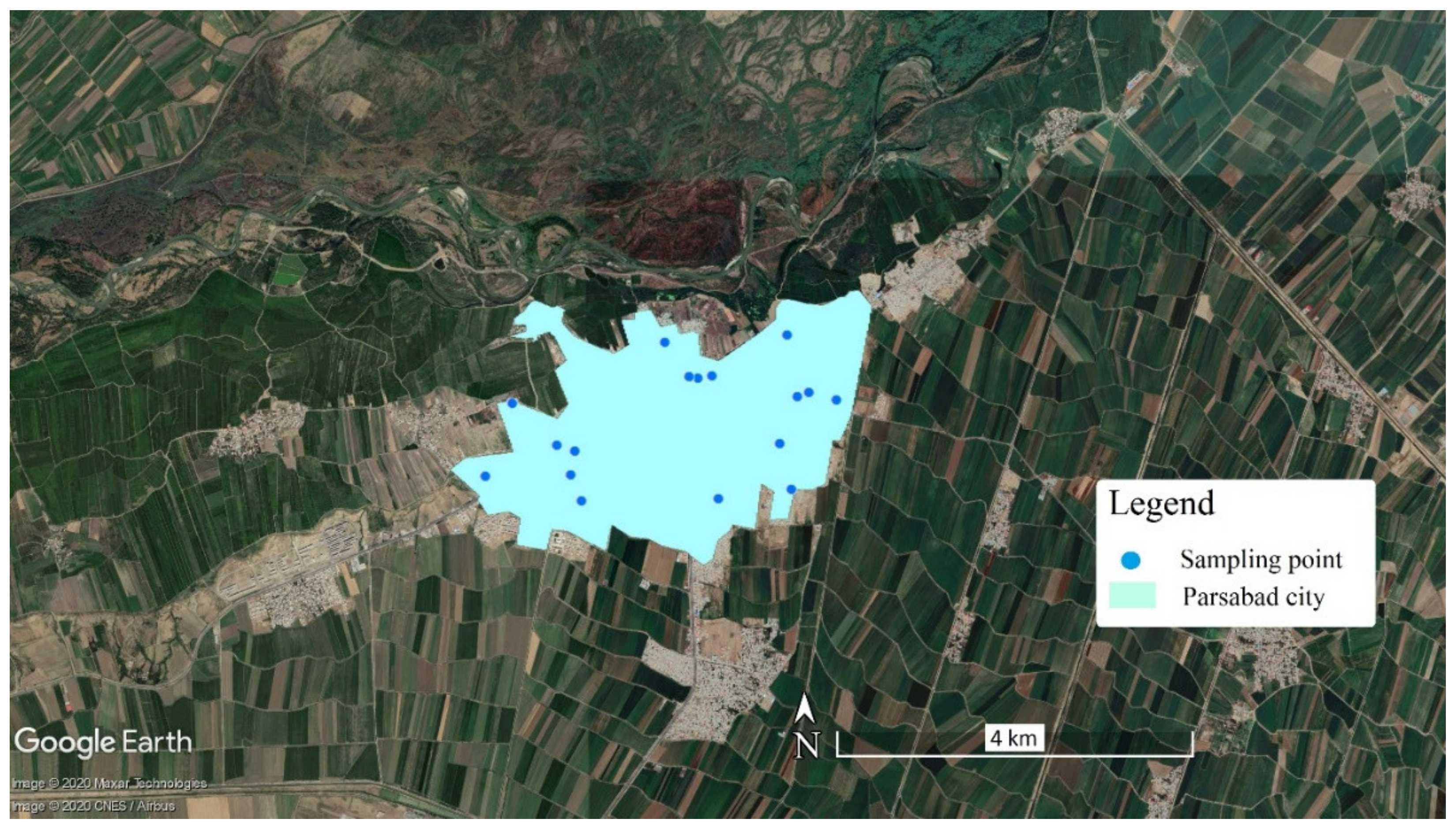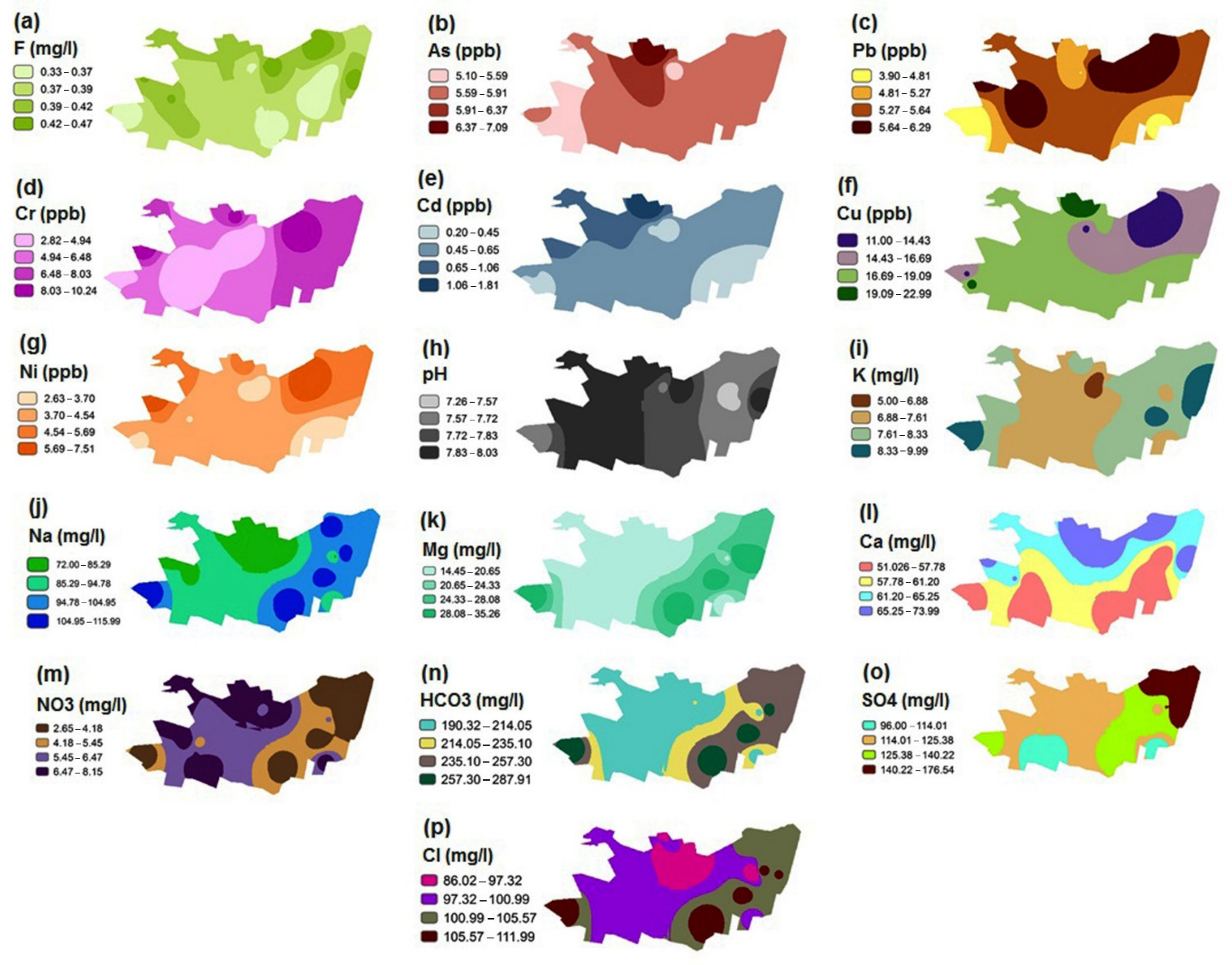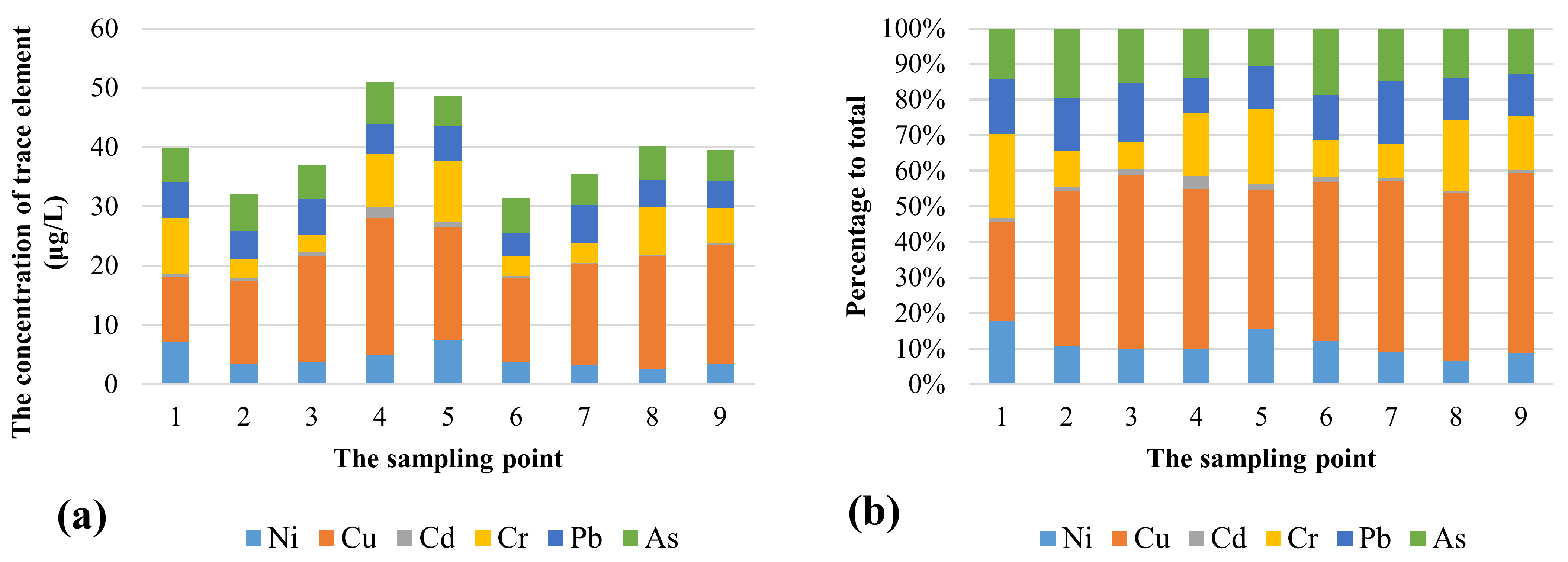Evaluation of Chemical Parameters of Urban Drinking Water Quality along with Health Risk Assessment: A Case Study of Ardabil Province, Iran
Abstract
1. Introduction
2. Materials and Methods
2.1. Study Area and Sampling
2.2. Water Quality Index Method
2.3. GIS Application
2.4. Health Risk Assessment
3. Results and Discussion
4. Conclusions
Author Contributions
Funding
Institutional Review Board Statement
Informed Consent Statement
Data Availability Statement
Acknowledgments
Conflicts of Interest
References
- Li, P.; Wu, J. Drinking Water Quality and Public Health. Expo. Health 2019, 11, 73–79. [Google Scholar] [CrossRef]
- Drinking Water. Available online: https://www.who.int/en/news-room/fact-sheets/detail/drinking-water (accessed on 7 December 2020).
- Giri, S.; Qiu, Z. Understanding the relationship of land uses and water quality in Twenty First Century: A review. J. Environ. Manag. 2016, 173, 41–48. [Google Scholar] [CrossRef] [PubMed]
- Bhateria, R.; Jain, D. Water quality assessment of lake water: A review. Sustain. Water Resour. Manag. 2016, 2, 161–173. [Google Scholar] [CrossRef]
- Abbasi, T.; Abbasi, S.A. Water Quality Indices; Elsevier: Amsterdam, The Netherlands, 2012; ISBN 978-0-444-54304-2. [Google Scholar]
- Wu, Z.; Wang, X.; Chen, Y.; Cai, Y.; Deng, J. Assessing river water quality using water quality index in Lake Taihu Basin, China. Sci. Total Environ. 2018, 612, 914–922. [Google Scholar] [CrossRef] [PubMed]
- Varnosfaderany, M.N.; Mirghaffary, N.; Ebrahimi, E.; Soffianian, A. Water quality assessment in an arid region using a water quality index. Water Sci. Technol. 2009, 60, 2319–2327. [Google Scholar] [CrossRef] [PubMed]
- Lobato, T.C.; Hauser-davis, R.A.; Oliveira, T.F.; Silveira, A.M.; Silva, H.A.N.; Tavares, M.R.M.; Saraiva, A.C.F. Construction of a novel water quality index and quality indicator for reservoir water quality evaluation: A case study in the Amazon region. J. Hydrol. 2015, 522, 674–683. [Google Scholar] [CrossRef]
- Hamlat, A.; Guidoum, A. Assessment of groundwater quality in a semiarid region of Northwestern Algeria using water quality index (WQI). Appl. Water Sci. 2018, 8, 220. [Google Scholar] [CrossRef]
- Gharibi, E.; Ghalit, M.; Taupin, J.D.; Patris, N.; Kouotou, D. Assessment of the quality of Moroccan bottled water by application of quality indices. J. Water Supply Res. Technol. AQUA 2018, 67, 576–585. [Google Scholar] [CrossRef]
- Ewaid, S.H.; Abed, S.A.; Al-Ansari, N.; Salih, R.M. Development and evaluation of a water quality index for the Iraqi rivers. Hydrology 2020, 7, 67. [Google Scholar] [CrossRef]
- Tian, Y.; Jiang, Y.; Liu, Q.; Dong, M.; Xu, D.; Liu, Y.; Xu, X. Using a water quality index to assess the water quality of the upper and middle streams of the Luanhe River, northern China. Sci. Total Environ. 2019, 667, 142–151. [Google Scholar] [CrossRef]
- Kachroud, M.; Trolard, F.; Kefi, M.; Jebari, S.; Bourrié, G. Water Quality Indices: Challenges and Application Limits in the Literature. Water 2019, 11, 361. [Google Scholar] [CrossRef]
- Ravikumar, P.; Mehmood, M.A.; Somashekar, R.K. Water quality index to determine the surface water quality of Sankey tank and Mallathahalli lake, Bangalore urban district, Karnataka, India. Appl. Water Sci. 2013, 3, 247–261. [Google Scholar] [CrossRef]
- Sahu, P.; Sikdar, P.K. Hydrochemical framework of the aquifer in and around East Kolkata Wetlands, West Bengal, India. Environ. Geol. 2008, 55, 823–835. [Google Scholar] [CrossRef]
- Vasanthavigar, M.; Srinivasamoorthy, K.; Vijayaragavan, K.; Rajiv Ganthi, R.; Chidambaram, S.; Anandhan, P.; Manivannan, R.; Vasudevan, S. Application of water quality index for groundwater quality assessment: Thirumanimuttar sub-basin, Tamilnadu, India. Environ. Monit. Assess. 2010, 171, 595–609. [Google Scholar] [CrossRef] [PubMed]
- Tiwari, A.; Singh, P.; Mahato, M. GIS-Based Evaluation of Water Quality Index of Groundwater Resources in West Bokaro coalfield, India. Curr. World Environ. 2014, 9, 843–850. [Google Scholar] [CrossRef]
- Rakib, M.A.; Sasaki, J.; Matsuda, H.; Quraishi, S.B.; Mahmud, M.J.; Bodrud-Doza, M.; Ullah, A.K.M.A.; Fatema, K.J.; Newaz, M.A.; Bhuiyan, M.A.H. Groundwater salinization and associated co-contamination risk increase severe drinking water vulnerabilities in the southwestern coast of Bangladesh. Chemosphere 2020, 246, 125646. [Google Scholar] [CrossRef]
- WHO. Guidelines for Drinking-Water Quality: Fourth Edition Incorporating the First Addendum; World Health Organization: Geneva, Switzerland, 2017; ISBN 978-92-4-154995-0. [Google Scholar]
- Karunanidhi, D.; Aravinthasamy, P.; Subramani, T.; Muthusankar, G. Revealing drinking water quality issues and possible health risks based on water quality index (WQI) method in the Shanmuganadhi River basin of South India. Environ. Geochem. Health 2021, 43, 931–948. [Google Scholar] [CrossRef]
- ISIRI. Drinking Water: Physical and Chemical Specifications (ISIRI No. 1053), 5th ed.; Institute of Standards and Industrial Research of Iran (ISIRI): Tehran, Iran, 2010; p. 26. [Google Scholar]
- Brown, R.M.; McClelland, N.I.; Deininger, R.A.; O’Connor, M.F. A Water Quality Index—Crashing the Psychological Barrier. In Indicators of Environmental Quality; Springer: Boston, MA, USA, 1972; pp. 173–182. [Google Scholar]
- Lkr, A.; Singh, M.R.; Puro, N. Assessment of water quality status of Doyang River, Nagaland, India, using Water Quality Index. Appl. Water Sci. 2020, 10, 1–13. [Google Scholar] [CrossRef]
- Bora, M.; Goswami, D.C. Water quality assessment in terms of water quality index (WQI): Case study of the Kolong River, Assam, India. Appl. Water Sci. 2017, 7, 3125–3135. [Google Scholar] [CrossRef]
- Meng, Q.; Liu, Z.; Borders, B.E. Assessment of regression kriging for spatial interpolation - Comparisons of seven GIS interpolation methods. Cartogr. Geogr. Inf. Sci. 2013, 40, 28–39. [Google Scholar] [CrossRef]
- Zeng, X.; Liu, Y.; You, S.; Zeng, G.; Tan, X.; Hu, X.; Hu, X.; Huang, L.; Li, F. Spatial distribution, health risk assessment and statistical source identification of the trace elements in surface water from the Xiangjiang River, China. Environ. Sci. Pollut. Res. 2015, 22, 9400–9412. [Google Scholar] [CrossRef]
- Ustaoğlu, F.; Tepe, Y.; Taş, B. Assessment of stream quality and health risk in a subtropical Turkey river system: A combined approach using statistical analysis and water quality index. Ecol. Indic. 2020, 113, 105815. [Google Scholar] [CrossRef]
- Wu, B.; Zhao, D.Y.; Jia, H.Y.; Zhang, Y.; Zhang, X.X.; Cheng, S.P. Preliminary risk assessment of trace metal pollution in surface water from Yangtze River in Nanjing section, China. Bull. Environ. Contam. Toxicol. 2009, 82, 405–409. [Google Scholar] [CrossRef] [PubMed]
- USEPA. Risk Assessment Guidance for Superfund Volume I: Human Health Evaluation Manual (Part E, Supplemental Guidance for Dermal Risk Assessment); U.S. Environmental Protection Agency: Washington, DC, USA, 2004.
- Rodriguez-Proteau, R.; Grant, R.L. Toxicity Evaluation and Human Health Risk Assessment of Surface and Ground Water Contaminated by Recycled Hazardous Waste Materials. In Water Pollution; Springer: Berlin/Heidelberg, Germany, 2005; pp. 133–189. [Google Scholar]
- Yu, G.; Wang, J.; Liu, L.; Li, Y.; Zhang, Y.; Wang, S. The analysis of groundwater nitrate pollution and health risk assessment in rural areas of Yantai, China. BMC Public Health 2020, 20, 1–6. [Google Scholar] [CrossRef] [PubMed]
- Wang, J.; Liu, G.; Liu, H.; Lam, P.K.S. Multivariate statistical evaluation ofdissolved trace elements and awater quality assessment in the middle reaches ofHuaihe River, Anhui, China. Sci. Total Environ. 2017, 583, 421–431. [Google Scholar] [CrossRef] [PubMed]
- Liang, B.; Han, G.; Liu, M.; Yang, K.; Li, X.; Liu, J. Distribution, sources, and water quality assessment of dissolved heavy metals in the Jiulongjiang river water, southeast China. Int. J. Environ. Res. Public Health 2018, 15, 2752. [Google Scholar] [CrossRef]
- Mohammadi, A.A.; Zarei, A.; Majidi, S.; Ghaderpoury, A.; Hashempour, Y.; Saghi, M.H.; Alinejad, A.; Hosseingholizadeh, N.; Ghaderpoori, M. Carcinogenic and non-carcinogenic health risk assessment of heavy metals in drinking water of Khorramabad, Iran. MethodsX 2019, 6, 1642–1651. [Google Scholar] [CrossRef]
- Nkpaa, K.W.; Amadi, B.A.; Wegwu, M.O. Hazardous metals levels in Groundwater from Gokana, Rivers State, Nigeria: Non-cancer and Cancer Health Risk Assessment. Hum. Ecol. Risk Assess. 2018, 24, 214–224. [Google Scholar] [CrossRef]
- Kusin, F.M.; Azani, N.N.M.; Hasan, S.N.M.S.; Sulong, N.A. Distribution of heavy metals and metalloid in surface sediments of heavily-mined area for bauxite ore in Pengerang, Malaysia and associated risk assessment. Catena 2018, 165, 454–464. [Google Scholar] [CrossRef]
- Yuswir, N.S.; Praveena, S.M.; Aris, A.Z.; Syed Ismail, S.N.; de Burbure, C.; Hashim, Z. Heavy Metal Contamination in Urban Surface Soil of Klang District (Malaysia). Soil Sediment Contam. 2015, 24, 865–881. [Google Scholar] [CrossRef]
- Yang, X.; Duan, J.; Wang, L.; Li, W.; Guan, J.; Beecham, S.; Mulcahy, D. Heavy metal pollution and health risk assessment in the Wei River in China. Environ. Monit. Assess. 2015, 187, 1–11. [Google Scholar] [CrossRef] [PubMed]
- Zeng, F.; Wei, W.; Li, M.; Huang, R.; Yang, F.; Duan, Y. Heavy Metal Contamination in Rice-Producing Soils of Hunan Province, China and Potential Health Risks. Int. J. Environ. Res. Public Health 2015, 12, 15584–15593. [Google Scholar] [CrossRef] [PubMed]
- Luo, X.; Ding, J.; Xu, B.; Wang, Y.; Li, H.; Yu, S. Incorporating bioaccessibility into human health risk assessments of heavy metals in urban park soils. Sci. Total Environ. 2012, 424, 88–96. [Google Scholar] [CrossRef] [PubMed]
- Bases & Design Criteria for Domestic Water Supply Projects (Standard No. 117-3); Ministry of Energy: Tehran, Iran, 1993.





| Parameter | Unit | WHO Standard | Iranian Standard | Weight (wi) | Relative Weight (Wi) |
|---|---|---|---|---|---|
| pH | - | 6.5–8.5 | 6.5–8.5 | 4 | 0.1176 |
| HCO3 | mg/L | 300 | - | 3 | 0.0882 |
| Cl | mg/L | 200–600 | 250–400 | 2 | 0.0588 |
| SO4 | mg/L | 400 | 250–400 | 4 | 0.1176 |
| NO3 | mg/L | 50 | 50 | 5 | 0.1471 |
| F | mg/L | 1.5 | - | 5 | 0.1471 |
| Ca | mg/L | 75–200 | 300 | 3 | 0.0882 |
| Mg | mg/L | 50–150 | 30 | 3 | 0.0882 |
| Na | mg/L | 200 | 200 | 3 | 0.0882 |
| K | mg/L | 10 | - | 2 | 0.0588 |
| ∑ wi = 34 | ∑ Wi= 1 |
| WQI Value | Water Quality Status | Possible Usage |
|---|---|---|
| 0–25 | Excellent | Drinking, irrigation, and industrial |
| 26–50 | Good | Drinking, irrigation, and industrial |
| 51–75 | Poor | Irrigation and industrial |
| 76–100 | Very poor | Irrigation |
| Above 100 | Unsuitable | Proper treatment required |
| Variable | Adults | Children |
|---|---|---|
| IR (L/day) | 2 | 0.64 |
| EF (day/year) | 350 | 350 |
| ED (year) | 30 | 6 |
| BW (kg) | 70 | 15 |
| AT (day) | 10,950 | 2190 |
| SA (cm2) | 18,000 | 6600 |
| ET (h/day) | 0.58 | 1 |
| RfDing | RfDder | Adult | Child | |||||||||
|---|---|---|---|---|---|---|---|---|---|---|---|---|
| ADDing | ADDder | HQing | HQder | HI | ADDing | ADDder | HQing | HQder | HI | |||
| Ca | 73.33 | 583.33 | 1.67 | 0.0088 | 0.0229 | 1.5 × 10−5 | 0.0229 | 2.5077 | 0.0259 | 0.0342 | 4.43 × 10−5 | 0.0342 |
| Mg | 7.33 | 58.33 | 0.61 | 0.0032 | 0.0838 | 5.5 × 10−5 | 0.0839 | 0.9181 | 0.0095 | 0.1252 | 1.62 × 10−4 | 0.1254 |
| Na | 48.88 | 388.88 | 2.56 | 0.0134 | 0.0524 | 3.43 × 10−5 | 0.0524 | 3.8242 | 0.0394 | 0.0782 | 1.01 × 10−4 | 0.0783 |
| K | 2.44 | 19.44 | 0.21 | 0.0011 | 0.0870 | 5.71 × 10−5 | 0.0871 | 0.3177 | 0.0033 | 0.1300 | 1.68 × 10−4 | 0.1301 |
| NO3 | 12.22 | 97.22 | 0.14 | 0.00078 | 0.0122 | 8.02 × 10−6 | 0.0122 | 0.3048 | 0.0023 | 0.0249 | 2.37 × 10−5 | 0.0250 |
| Cu | 0.24 | 1.94 | 0.00047 | 2.46 × 10−6 | 0.0019 | 1.27 × 10−6 | 0.0019 | 0.00070 | 7.26 × 10−6 | 0.0029 | 3.74 × 10−6 | 0.0029 |
| F | 0.36 | 2.91 | 0.0109 | 5.67 × 10−5 | 0.0297 | 1.95 × 10−5 | 0.0297 | 0.0162 | 0.00016 | 0.0443 | 5.74 × 10−5 | 0.0444 |
| CSF | Adult | Child | |||||||||
|---|---|---|---|---|---|---|---|---|---|---|---|
| ADDing | ADDder | CRing | CRder | CRtotal | ADDing | ADDder | CRing | CRder | CRtotal | ||
| Ni | 0.84 | 1.21 × 10−4 | 1.26 × 10−7 | 1.02 × 10−4 | 1.06 × 10−7 | 1.02 × 10−4 | 1.81 × 10−4 | 3.73 × 10−7 | 1.52 × 10−4 | 3.13 × 10−7 | 1.52 × 10−4 |
| Cd | 6.3 | 1.66 × 10−5 | 8.69 × 10−8 | 1.05 × 10−4 | 5.47 × 10−7 | 1.05 × 10−4 | 2.48 × 10−5 | 2.56 × 10−7 | 1.57 × 10−4 | 1.61 × 10−6 | 1.58 × 10−4 |
| Cr | 0.5 | 1.68 × 10−4 | 1.75 × 10−6 | 8.42 × 10−5 | 8.78 × 10−7 | 8.50 × 10−5 | 2.51 × 10−4 | 5.18 × 10−6 | 1.26 × 10−4 | 2.59 × 10−6 | 1.28 × 10−4 |
| Pb | 0.0085 | 1.44 × 10−4 | 7.54 × 10−8 | 1.23 × 10−6 | 6.41×10−10 | 1.23 × 10−6 | 2.15 × 10−4 | 2.22 × 10−7 | 1.84 × 10−6 | 1.89 × 10−9 | 1.84 × 10−6 |
| As | 1.5 | 1.57 × 10−4 | 8.22 × 10−7 | 2.36 × 10−4 | 1.23 × 10−6 | 2.37 × 10−4 | 2.35 × 10−4 | 2.42 × 10−6 | 3.53 × 10−4 | 3.63 × 10−6 | 3.56 × 10−4 |
Publisher’s Note: MDPI stays neutral with regard to jurisdictional claims in published maps and institutional affiliations. |
© 2021 by the authors. Licensee MDPI, Basel, Switzerland. This article is an open access article distributed under the terms and conditions of the Creative Commons Attribution (CC BY) license (https://creativecommons.org/licenses/by/4.0/).
Share and Cite
Aghlmand, R.; Rasi Nezami, S.; Abbasi, A. Evaluation of Chemical Parameters of Urban Drinking Water Quality along with Health Risk Assessment: A Case Study of Ardabil Province, Iran. Int. J. Environ. Res. Public Health 2021, 18, 5179. https://doi.org/10.3390/ijerph18105179
Aghlmand R, Rasi Nezami S, Abbasi A. Evaluation of Chemical Parameters of Urban Drinking Water Quality along with Health Risk Assessment: A Case Study of Ardabil Province, Iran. International Journal of Environmental Research and Public Health. 2021; 18(10):5179. https://doi.org/10.3390/ijerph18105179
Chicago/Turabian StyleAghlmand, Reza, Saeed Rasi Nezami, and Ali Abbasi. 2021. "Evaluation of Chemical Parameters of Urban Drinking Water Quality along with Health Risk Assessment: A Case Study of Ardabil Province, Iran" International Journal of Environmental Research and Public Health 18, no. 10: 5179. https://doi.org/10.3390/ijerph18105179
APA StyleAghlmand, R., Rasi Nezami, S., & Abbasi, A. (2021). Evaluation of Chemical Parameters of Urban Drinking Water Quality along with Health Risk Assessment: A Case Study of Ardabil Province, Iran. International Journal of Environmental Research and Public Health, 18(10), 5179. https://doi.org/10.3390/ijerph18105179






